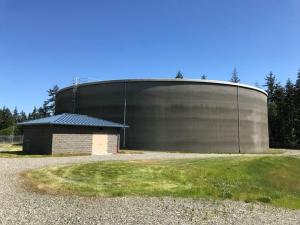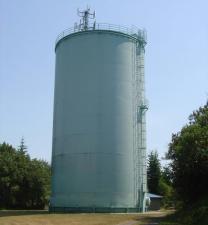Water Treatment Facility & Reservoirs
In January 2017, the City of Port Townsend completed construction of the pressurized membrane ultrafiltration Water Treatment Facility that is capable of treating up to 2.95 million gallons of water per day. The treatment process complies with increased State and Federal standards for adequate treatment for the cryptosporidium parasite. After filtration, chlorine is added to the water to meet disinfection requirements.
Port Townsend’s water comes from 37,361-acres of watershed in the Olympic Mountains that drain into the Big Quilcene and Little Quilcene Rivers.
5 Million Gallon Reservoir
The 5-million gallon concrete reservoir serves the lower elevations within the City. It provides required storage to ensure adequate pressure and water for firefighting throughout much of the City. It also allows treated water adequate “contact time” with chlorine before being delivered to homes and businesses.
1 Million Gallon Standpipe
The City’s 1 million gallon standpipe is a steel water storage tank, which stands 84 feet tall. It provides water pressure for homes and businesses in the higher elevation zone of the distribution system.



Water Quality
Hardness
Hardness is caused by compounds of calcium and magnesium, and by a variety of other metals. General guidelines for classification of waters are: 0 to 60 mg/L (milligrams per liter) as calcium carbonate is classified as soft; 61 to 120 mg/L as moderately hard; 121 to 180 mg/L as hard; and more than 180 mg/L as very hard. Hard water is not a health risk, but minerals can build up on fixtures, leave spots or film on dishes and require more soap and/or detergent for cleaning.
There are two different general measurements used to describe the hardness of water:
- mg/L (as calcium carbonate), same as parts per million
- grains/gallon (1 grain of hardness equals 17.1 mg/L or ppm of hardness)
Port Townsend’s source water is considered soft at an average of 45 mg/L (as CaCO3) or 2.6 grains per gallon.
Fluoride
The City of Port Townsend does not add fluoride to the drinking water. Fluoride is also a naturally-occurring element found in soil and water however, it is not detected in the City’s source water.
Taste and Odor
The water treatment process itself uses chlorine as a disinfectant which can cause a faint bleachy odor. Water which resides in pipes for long periods of time through lack of use can develop a stale taste or odor. Stale water conditions may occur in dead ends on the distribution system.
Some species of naturally occurring algae can produce chemicals which impart earthy, musty or moldy odors to water. Decaying organic material, such as leaves, aquatic plants and algae may cause swampy, grassy, woody or septic tastes or odors.
Unpleasant tastes or odors in drinking water may indicate unsafe plumbing conditions called cross-connections. A cross connection is a physical connection between a potable (drinkable) water supply and a source of contamination or pollution.
Water mains are flushed periodically, especially in dead-end locations, to remove mineral deposits, sediment and replace stale water with fresh water.
Our system is continuously monitored to maintain a high level of quality. Water quality may change within the distribution system and customers can help provide information about local water conditions. If you have a concern about your water quality, call (360) 379-5001. Quality problems may be caused by on-site plumbing conditions beyond our jurisdiction, if so, you may need the services of a plumber.
Lead
Lead in drinking water most often comes from water distribution lines or household plumbing rather than from the water system source. Plumbing sources can include lead pipes, lead solder, faucets, valves, and other components made of brass. Lead from other sources (such as lead-based paint and contaminated dust or soil) can increase a person’s overall exposure, which adds to the effects of lead in water.
The greatest risk of lead exposure is to infants, young children, and pregnant women. Lead can cause serious health problems if too much enters the body. Lead is stored in the bones and can be released later in life. Lead can cause damage to the brain and kidneys, interfere with production of red blood cells that carry oxygen, and may result in lowered IQ in children. During pregnancy, the child receives lead from the mother’s bones, which may affect brain development. Low levels of lead can affect adults with high blood pressure or kidney problems.
How you can reduce exposure
- Run your water. Before drinking, flush your home’s pipes by running the tap, taking a shower, doing laundry, or doing a load of dishes. The amount of time to run the water will depend on length of your home plumbing. Residents should contact their water utility for recommendations about flushing times in their community.
- Use cold water. Use only cold water for drinking, cooking and making baby formula. Remember, boiling water does not remove lead from water.
- Clean your aerator. Regularly clean your faucet’s screen (also known as an aerator). Sediment, debris, and lead particles can collect in your aerator. If lead particles are caught in the aerator, lead can get into your water.
- Use your filter properly. If you use a filter, make sure you use a filter certified to remove lead. Read the directions to learn how to properly install and use your cartridge and when to replace it. Using the cartridge after it has expired can make it less effective at removing lead. Do not run hot water through the filter.
Additional information about lead is available the EPA web site.
Discolored Water
What is happening if the water coming out of the tap may be yellow or light brown colored?
The cause is usually the presence of iron and manganese minerals. The minerals may be coming from a number of sources including:
- If you have older galvanized iron plumbing it may be rusting.
- Your hot water tank may be rusting, or sediments have accumulated in the hot water tank. If this is the case, you will only see it while running the hot water.
- Naturally-occurring sediments in the water distribution system can be stirred up. This may occur during a water main break or in an area where a fire hydrant has been used, such as when performing the annual water main flushing.
What You Can Do
If your water clears up when you run a tap for a minute, or the discoloration is only in your hot water, then the problem is most likely within your home plumbing. Homeowners are responsible for issues on their side of the meter. The City is responsible for the water delivery to your property. You can call us at (360)379-5001 to help investigate the problem.
